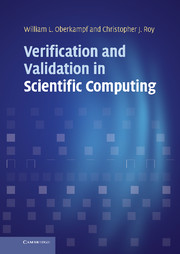Book contents
- Frontmatter
- Contents
- Preface
- Acknowledgments
- 1 Introduction
- Part I Fundamental concepts
- Part II Code verification
- 4 Software engineering
- 5 Code verification
- 6 Exact solutions
- Part III Solution verification
- Part IV Model validation and prediction
- Part V Planning, management, and implementation issues
- Appendix Programming practices
- Index
- Plate Section
- References
6 - Exact solutions
from Part II - Code verification
Published online by Cambridge University Press: 05 March 2013
- Frontmatter
- Contents
- Preface
- Acknowledgments
- 1 Introduction
- Part I Fundamental concepts
- Part II Code verification
- 4 Software engineering
- 5 Code verification
- 6 Exact solutions
- Part III Solution verification
- Part IV Model validation and prediction
- Part V Planning, management, and implementation issues
- Appendix Programming practices
- Index
- Plate Section
- References
Summary
The primary focus of this chapter is on the use of exact solutions to mathematical models for code verification. Recall that, in some cases, software testing can be performed by simply running the code and comparing the results to the correct code output. However, in scientific computing, “correct” code output depends on the chosen spatial mesh, time step, iterative convergence tolerance, machine precision, etc. We are thus forced to rely on other less definitive methods for assessing code correctness. In Chapter 5, the order of accuracy test was argued to be the most rigorous approach for code verification. When the order of accuracy test fails, or when the formal order of accuracy has not been determined, then the less rigorous convergence test may be used. In either case, an exact solution to the underlying mathematical model is required. When used for code verification, the ability of this exact solution to exercise all terms in the mathematical model is more important than any physical realism of the solution. In fact, realistic exact solutions are often avoided for code verification due to the presence of singularities and/or discontinuities. Numerous examples will be given in this chapter of exact solutions and their use with the order verification test. The final example given in this chapter employs the less rigorous convergence test with benchmark numerical solutions. In addition to code verification applications, exact solutions to mathematical models are extremely valuable for evaluating the accuracy of numerical schemes, determining solution sensitivity to mesh quality and topology, evaluating the reliability of discretization error estimators, and evaluating solution adaptation schemes. For these secondary applications, physically realistic exact solutions are preferred (see Section 6.4).
- Type
- Chapter
- Information
- Verification and Validation in Scientific Computing , pp. 208 - 248Publisher: Cambridge University PressPrint publication year: 2010



